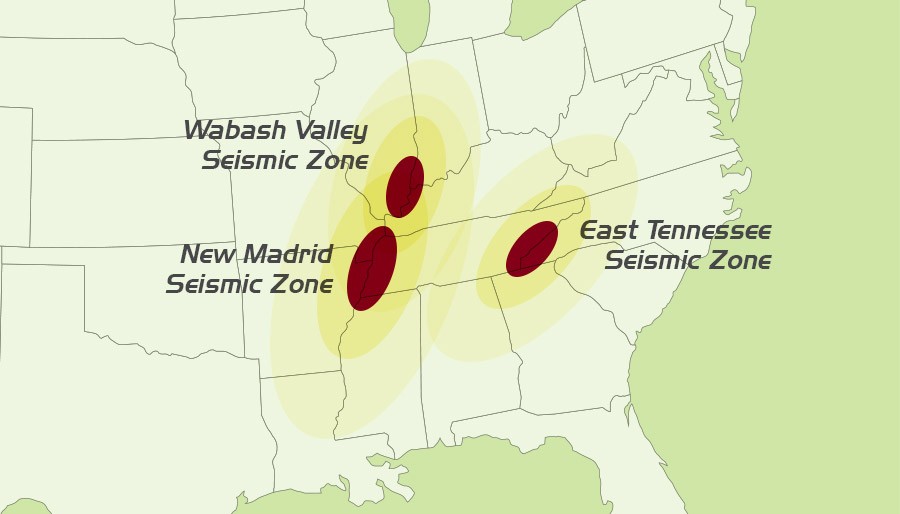About Shaken Fury and Ardent Sentry
The Tennessee National Guard is preparing an exercise in order to measure response to a devastating earthquake occuring within the New Madrid Seismic Zone.
The New Madrid Seismic Zone
The New Madrid Seismic Zone (NMSZ), region of poorly understood, deep-seated faults in Earth’s crust that zigzag southwest-northeast through Arkansas, Missouri, Tennessee, and Kentucky, U.S. Lying in the central area of the North American Plate, the seismic zone is about 45 miles (70 km) wide and about 125 miles (200 km) long. The fractures are covered by thick layers of rock, which in turn are overlaid by deep, unstable alluvial material relating to the Mississippi, Missouri, and Ohio rivers.
Some Earth scientists suggest that fracturing in this region resulted from stresses brought on by the downcutting of the Mississippi River into the surrounding landscape between 10,000 and 16,000 years ago. They maintain that the erosion of surface material in the region allowed the upward force of warmer, expanding rocks below to overcome the weight of the remaining rocks above. Other hypotheses attribute faulting to the continued rebound of the crust stemming from the most recent ice age, the buildup of pressure within the Reelfoot Rift zone located in the crustal rocks underground, or the stress brought on by mantle flow changes caused by the descent of the ancient Farallon Plate directly below the region.

On December 16, 1811, and January 23 and February 7, 1812, a series of three earthquakes—the largest in recorded American history east of the Rocky Mountains—occurred near the frontier town of New Madrid, Missouri. (epicentre 36.6° N 89.6° W), each measuring greater than magnitude 7.0. Thousands of milder aftershocks occurred daily for more than a year. The first shock was felt from Canada to New Orleans and as far away as Boston, Massachusetts and Washington, D.C. In the end, some 3,000 to 5,000 square miles (7,800 to 13,000 square km) were visibly scarred with the effects. Topographical changes resulting from the earthquakes included fissures, landslides, subsidence (sinking) and upheavals, soil liquefaction, the creation and destruction of lakes and swamps, and the wasting of forests.
New Madrid Seismic Zone info from britannica.com
Disaster Preparation Kits

Everyone should have disaster preparation kits. Keep them where you spend most of your time, so they can be reached in an emergency situation. The kits will be useful for many emergencies.
Store your kits in accessible locations at home, at work and in your vehicle. Having emergency supplies readily available can reduce the impact of an earthquake, a terrorist incident or other emergency on you and your family. Your disaster preparation kits should include food, water, flashlights, portable radios, batteries, a first aid kit, cash, extra medications, a whistle, fire extinguisher, etc.
Keep one kit in your home, another in your car, and a third kit at work. Backpacks or other small bags are best for your disaster supplies kits so you can take them with you if you have to evacuate.
Include at least the following items:
- Medications, prescription list, copies of medical cards, doctor’s name and contact information. Also include medical consent forms for dependents.
- First aid kit and handbook, include examination gloves (non-latex)
- Dust mask
- Spare eyeglasses or contact lenses and cleaning solution
- Bottled water
- Whistle (to alert rescuers to your location)
- Sturdy shoes
- Emergency cash
- Road maps
- List of emergency out-of-area contact phone numbers
- Snack foods, high in water and calories
- Working flashlight with extra batteries and light bulbs, or light sticks
- Personal hygiene supplies
- Comfort items such as games, crayons, writing materials, teddy bears
- Toiletries and special provisions you need for yourself and others in your family including elderly, disabled, small children, and animals.
- Copies of personal identification (drivers license, work ID card, etc.)
Info from earthquakecountry.org
Websites with Helpful Information
For more information please visit: